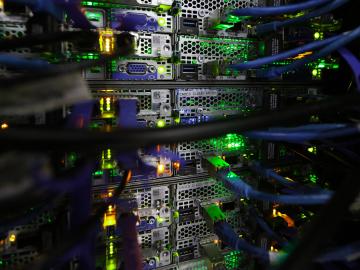
Filter News
Area of Research
- Advanced Manufacturing (1)
- Biological Systems (1)
- Biology and Environment (10)
- Computer Science (2)
- Energy Science (27)
- Isotopes (1)
- Materials (12)
- Materials for Computing (2)
- National Security (4)
- Neutron Science (16)
- Nuclear Science and Technology (6)
- Quantum information Science (6)
- Supercomputing (30)
News Topics
- (-) Bioenergy (22)
- (-) Biomedical (27)
- (-) Biotechnology (3)
- (-) Grid (12)
- (-) National Security (2)
- (-) Quantum Science (24)
- (-) Space Exploration (6)
- 3-D Printing/Advanced Manufacturing (43)
- Advanced Reactors (21)
- Artificial Intelligence (20)
- Big Data (18)
- Biology (5)
- Buildings (1)
- Chemical Sciences (5)
- Clean Water (7)
- Composites (3)
- Computer Science (74)
- Coronavirus (25)
- Critical Materials (2)
- Cybersecurity (9)
- Energy Storage (29)
- Environment (48)
- Exascale Computing (5)
- Frontier (3)
- Fusion (18)
- High-Performance Computing (3)
- Isotopes (9)
- Machine Learning (13)
- Materials (2)
- Materials Science (57)
- Mathematics (2)
- Mercury (2)
- Microscopy (13)
- Molten Salt (3)
- Nanotechnology (23)
- Neutron Science (56)
- Nuclear Energy (48)
- Physics (19)
- Polymers (9)
- Security (5)
- Summit (26)
- Transportation (27)
Media Contacts

As the second-leading cause of death in the United States, cancer is a public health crisis that afflicts nearly one in two people during their lifetime.

Researchers at ORNL demonstrated that sodium-ion batteries can serve as a low-cost, high performance substitute for rechargeable lithium-ion batteries commonly used in robotics, power tools, and grid-scale energy storage.

Oak Ridge National Laboratory will partner with Cincinnati Children’s Hospital Medical Center to explore ways to deploy expertise in health data science that could more quickly identify patients’ mental health risk factors and aid in

A team from the ORNL has conducted a series of experiments to gain a better understanding of quantum mechanics and pursue advances in quantum networking and quantum computing, which could lead to practical applications in cybersecurity and other areas.

Researchers have developed a new process that could make it much cheaper to produce biofuels such as ethanol from plant waste and reduce reliance on fossil fuels.

A select group gathered on the morning of Dec. 20 at the Department of Energy’s Oak Ridge National Laboratory for a symposium in honor of Liane B. Russell, the renowned ORNL mammalian geneticist who died in July.

To better determine the potential energy cost savings among connected homes, researchers at Oak Ridge National Laboratory developed a computer simulation to more accurately compare energy use on similar weather days.

Illustration of the optimized zeolite catalyst, or NbAlS-1, which enables a highly efficient chemical reaction to create butene, a renewable source of energy, without expending high amounts of energy for the conversion. Credit: Jill Hemman, Oak Ridge National Laboratory/U.S. Dept. of Energy

A technology developed at the ORNL and scaled up by Vertimass LLC to convert ethanol into fuels suitable for aviation, shipping and other heavy-duty applications can be price-competitive with conventional fuels

If humankind reaches Mars this century, an Oak Ridge National Laboratory-developed experiment testing advanced materials for spacecraft may play a key role.


